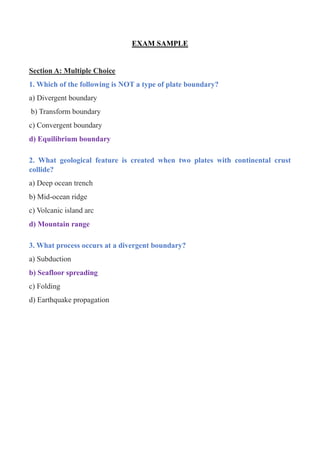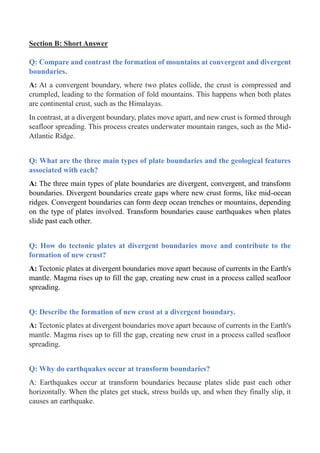Plate Boundaries - exam style questions
- 1. Big Write About Plate Boundaries (280 words) The Earth's outer layer, called the crust, is divided into several large and small plates. These plates are always moving, although very slowly. There are three main types of plate boundaries where the plates interact: 1. Divergent boundaries: When plates move away from each other, it creates a gap. Magma (molten rock) rises up from the Earth's mantle to fill this gap, creating new crust. This process happens mainly under the oceans, forming underwater mountain ranges called mid-ocean ridges. 2. Convergent boundaries: When plates collide, they can create different kinds of interactions: (a) If two plates with oceanic crust collide, one plate will be forced beneath the other in a process called subduction. This forms deep ocean trenches and can lead to volcanic activity. (b) If two plates with continental crust collide, they push against each other, creating mountains. The Himalayas are an example of two continental plates. (c) If one continental and one oceanic plate collide into each other, the denser oceanic plate sinks beneath the continental plate in a process called subduction. This can result in the formation of deep ocean trenches and volcanic activity. 3. Transform boundaries: When plates slide past each other horizontally, it forms a transform boundary. These boundaries are known for their occurrence of earthquakes, such as the San Andreas Fault. The movement of tectonic plates causes geological events like earthquakes, volcanic eruptions, and mountains. Earthquakes occur when the plates get stuck and suddenly release built-up energy, causing the ground to shake. Volcanic eruptions happen when molten rock (magma) reaches the surface through cracks in the crust. Studying tectonic plates is important because it helps scientists understand the Earth's history, predict earthquakes and volcanic activity.
- 2. EXAM SAMPLE Section A: Multiple Choice 1. Which of the following is NOT a type of plate boundary? a) Divergent boundary b) Transform boundary c) Convergent boundary d) Equilibrium boundary 2. What geological feature is created when two plates with continental crust collide? a) Deep ocean trench b) Mid-ocean ridge c) Volcanic island arc d) Mountain range 3. What process occurs at a divergent boundary? a) Subduction b) Seafloor spreading c) Folding d) Earthquake propagation
- 3. Section B: Short Answer Q: Compare and contrast the formation of mountains at convergent and divergent boundaries. A: At a convergent boundary, where two plates collide, the crust is compressed and crumpled, leading to the formation of fold mountains. This happens when both plates are continental crust, such as the Himalayas. In contrast, at a divergent boundary, plates move apart, and new crust is formed through seafloor spreading. This process creates underwater mountain ranges, such as the Mid- Atlantic Ridge. Q: What are the three main types of plate boundaries and the geological features associated with each? A: The three main types of plate boundaries are divergent, convergent, and transform boundaries. Divergent boundaries create gaps where new crust forms, like mid-ocean ridges. Convergent boundaries can form deep ocean trenches or mountains, depending on the type of plates involved. Transform boundaries cause earthquakes when plates slide past each other. Q: How do tectonic plates at divergent boundaries move and contribute to the formation of new crust? A: Tectonic plates at divergent boundaries move apart because of currents in the Earth's mantle. Magma rises up to fill the gap, creating new crust in a process called seafloor spreading. Q: Describe the formation of new crust at a divergent boundary. A: Tectonic plates at divergent boundaries move apart because of currents in the Earth's mantle. Magma rises up to fill the gap, creating new crust in a process called seafloor spreading. Q: Why do earthquakes occur at transform boundaries? A: Earthquakes occur at transform boundaries because plates slide past each other horizontally. When the plates get stuck, stress builds up, and when they finally slip, it causes an earthquake.
- 4. Q: What happens when oceanic plates and continental plates collide at convergent boundaries? A: When oceanic plates collide with continental plates at convergent boundaries, the denser oceanic plate sinks beneath the continental plate in a process called subduction. This can result in the formation of deep ocean trenches and volcanic activity. Q: Explain the process of subduction at a convergent boundary. A: When oceanic plates collide with continental plates at convergent boundaries, the denser oceanic plate sinks beneath the continental plate in a process called subduction. This can result in the formation of deep ocean trenches and volcanic activity. Q: Why do earthquakes occur at transform boundaries? A: Earthquakes occur at transform boundaries because plates slide past each other horizontally. When the plates get stuck, stress builds up, and when they finally slip, it causes an earthquake. Q: Compare and contrast the formation of volcanic activity at convergent and divergent plate boundaries. A: At convergent boundaries, volcanic activity occurs when the denser oceanic plate sinks beneath the continental plate, causing melting and the formation of magma. At divergent boundaries, volcanic activity happens when plates move apart, allowing magma to rise and create new crust. Q: How are mountain ranges formed in relation to plate boundaries? A: Mountain ranges are formed at convergent plate boundaries. When two continental plates collide, they crumple and fold, creating fold mountains. Such as the Himalayas. Q: How do scientists monitor and predict volcanic eruptions and earthquakes? A: Scientists monitor volcanic eruptions by measuring ground deformation, gas emissions, and seismic activity using instruments like seismographs and gas analyzers. For earthquakes, they use seismographs to measure ground movements and study patterns of seismic activity.
- 5. Q: How has the theory of plate tectonics contributed to our understanding of Earth's geological history? A: The theory of plate tectonics explains how continents move and interact, helping us understand the formation of geological features over millions of years. It also helps explain the occurrence of earthquakes, volcanic activity, and the distribution of fossils on different continents. Q: What is subduction and how does it occur at convergent plate boundaries? A: Subduction is the process where one plate sinks beneath another plate at a convergent boundary. It occurs when an oceanic plate collides with either another oceanic plate or a continental plate. The denser plate is forced beneath the less dense plate into the Earth's mantle, leading to the formation of deep ocean trenches and volcanic activity. Q: What are the potential hazards and benefits of living near tectonic plate boundaries? A: Living near plate boundaries can have hazards such as earthquakes, tsunamis, and volcanic eruptions, which can cause damage and loss of life. However, there are also benefits like access to geothermal energy, fertile soils due to volcanic activity, and potential tourism related to geological features.
- 6. Section C: Diagram Analysis Study the diagram below, which represents a plate boundary, and answer the questions that follow. Q: Identify the type of plate boundary shown in the diagram. A: The type of plate boundary shown in the diagram is a transform boundary. Q: Explain the geological features that are likely to form at this plate boundary. A: At a transform boundary, plates slide past each other horizontally. This movement can cause earthquakes as the plates get stuck and then suddenly release the built-up stress. The San Andreas Fault is an example of a transform boundary where frequent earthquakes occur. Q: Discuss the potential hazards associated with this type of plate boundary. A: Transform boundaries can have potential hazards. The main hazard is the occurrence of earthquakes, which can cause damage to buildings and infrastructure, as well as a great loss in human life; leaving people stuck under the debris and the destroyed houses. Section D: Essay 10. Discuss the significance of plate tectonics in shaping the Earth's surface and impacting human activities. Provide specific examples to support your answer. A: Plate tectonics is significant in shaping the Earth's surface and impacting human activities. The movement of tectonic plates creates various geological features such as mountains, volcanoes, and oceanic trenches. For example, the formation of the Himalayas through the collision of the Indian and Eurasian plates has shaped the landscape and provided natural barriers. Volcanic activity, has impacted human settlements and led to historical events. Additionally, plate tectonics is responsible for the occurrence of earthquakes, which can cause destruction and a loss in human lives as well as infrastructure and buildings.





